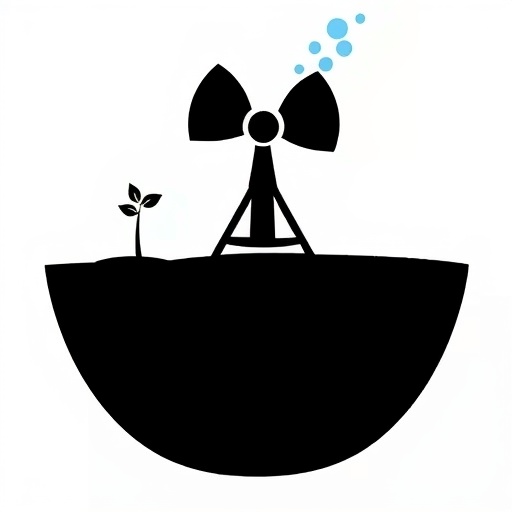In a groundbreaking study, researchers have turned their attention to the radioactive properties of phosphate ore and its resultant fertilizers in Saudi Arabia. The objective was to evaluate the radiological impact of these substances using gamma spectrometry, a highly effective technique in assessing radioactivity concentrations. The implications of their findings could be profound, affecting not only agricultural practices but also public health and environmental policies.
Phosphate rock is a vital resource for a wide range of applications, particularly in agriculture as a fertilizer. However, it has been determined that this seemingly innocuous mineral can harbor various radionuclides, which can lead to significant radiation exposure when improperly managed. Understanding the radiological aspects of phosphate ore and associated fertilizers is crucial, particularly in a region like Saudi Arabia, where agricultural expansion and development are urgent.
The research team, consisting of M.H. Nassef, M.M.T. Qutub, and O.A. Fallatah, implemented a comprehensive gamma spectrometry analysis. This technique allows for the precise quantification of radioactive isotopes present within various samples. It involves measuring the energy of gamma rays emitted by the isotopes, which divulges critical information on their concentration levels.
Previous studies have indicated that phosphate mining operations can lead to the release of radium, uranium, and thorium isotopes—elements known for their hazardous nature. This reinforces the necessity for continuous monitoring and assessment of environmental conditions in areas where phosphate mining and fertilizer production occur. By conducting their research, the scientists aimed to fill gaps in existing data and provide much-needed clarity on the potential health dangers associated with these substances.
One of the key aspects of the research involved sampling various phosphate ore and fertilizer products from different regions in Saudi Arabia. This geographical diversity provides a comprehensive view of the radiological landscape associated with phosphate operations in the country. Each sample was carefully processed and analyzed, ensuring minimal contamination and accurate gamma spectral readings.
The results highlighted considerable variation in radioactivity concentrations across the samples. Particularly worrisome was the detection of elevated levels of radium-226 and potassium-40, two isotopes that pose known health risks. If these radioactive elements enter the food chain through agricultural practices or contaminate soil and water sources, the consequences could be dire for both human health and ecosystems alike.
More significantly, the research emphasized the importance of regulatory frameworks regarding mining and fertilizer processing in the country. While phosphate mining plays a crucial role in the agricultural sector, stringent regulations must be in place to mitigate the risks associated with radiation exposure. Policymakers should consider these findings as they develop guidelines for safe agricultural practices and monitor the use of fertilizers that may carry radioactive materials.
The study’s findings also emphasize the pressing need for public education surrounding the use of fertilizers and the impact of their ingredients. Many farmers may be unaware of the potential hazards of using phosphate-based fertilizers that could contain significant levels of radiation. Outreach and educational initiatives targeting agricultural communities may foster safer practices and promote better understanding of the risks involved.
In conclusion, the investigation led by Nassef, Qutub, and Fallatah stands as a testament to the importance of environmental monitoring and public health. It not only sheds light on the radioactive properties of phosphate ores but also calls for immediate action to address these concerns. By integrating scientific research into policy-making and community education, Saudi Arabia can pave the way for safer agricultural practices and a healthier future for its population.
As the research community continues to delve into the implications of phosphate radioactivity, it becomes abundantly clear that a holistic approach is essential. This study serves as a step towards creating awareness, advancing scientific inquiry, and implementing the necessary precautions. Ultimately, the goal should be to ensure a balance between agricultural prosperity and the safeguarding of environmental health.
This research exemplifies how scientific findings can have far-reaching implications for policies impacting public welfare. As more data becomes available and methodologies improve, the scientific community will be better equipped to address and manage the environmental challenges posed by industrial activities and their potential risks.
It is through research endeavors like these that societies can both harness natural resources and protect health. The world awaits further studies, and the dialogue surrounding concerning issues like radioactivity in fertilizers must continue. Only then can sustainable practices be promoted and enacted.
Subject of Research: Radioactivity concentrations in phosphate ore and fertilizer
Article Title: Determination of radioactivity concentrations in phosphate ore and fertilizer to assess their radiological impacts using gamma spectrometry technique in Saudi Arabia.
Article References:
Nassef, M.H., Qutub, M.M.T., Fallatah, O.A. et al. Determination of radioactivity concentrations in phosphate ore and fertilizer to assess their radiological impacts using gamma spectrometry technique in Saudi Arabia. Environ Monit Assess 197, 1181 (2025). https://doi.org/10.1007/s10661-025-14606-1
Image Credits: AI Generated
DOI: 10.1007/s10661-025-14606-1
Keywords: Phosphate ore, fertilizer, radioactivity, gamma spectrometry, Saudi Arabia, environmental health, public safety, agricultural practices.




